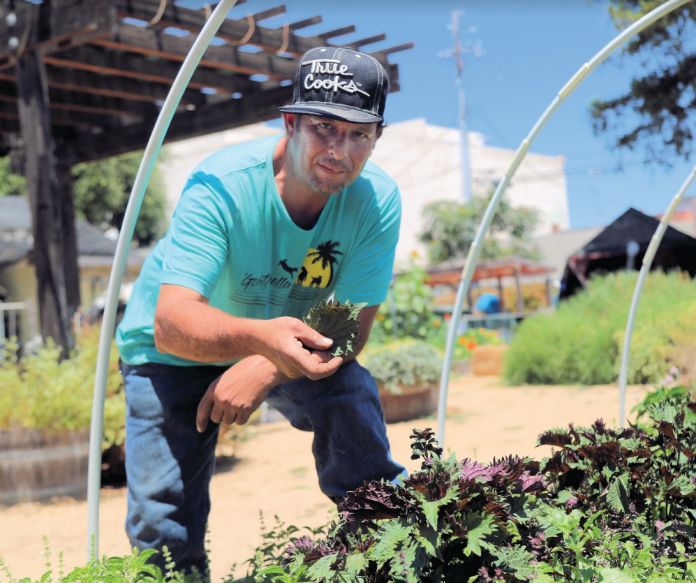
One of the hottest culinary trends this summer, edible flowers, has a local champion in David Jamrock, the chef behind the sumptuous farm dinners at a downtown garden in Gilroy.
Yet, while it took the influence of Food Network cooking programs to get people to try rose petals on their cupcakes and lavender in their lamb roasts, Jamrock, a professional chef who once fed ’50s-era Hollywood Glitterati and United States Presidents at a high-end resort in Palm Springs, has been cooking with and growing edible flowers at his Hollister ranch for years.
“I had wild elderberries and peppercorns growing on the property that I would pick for a restaurant. About six years ago they asked if I could plant some marigolds and it steamrolled from there,” said Jamrock recently during some unusual downtime.
In addition to planning and executing the alfresco feasts at the Gilroy Demonstration Garden, Jamrock sells at the destination farmers market at the Ferry Building in San Francisco and grows about 25 different varieties of edible flowers at his ranch near Lover’s Lane in Hollister.
“I have snapdragons, hollyhock, gladiolus, pansies, violas,” said Jamrock, listing the fragile and enchanting ingredients that his customers use to enliven and beautify their dishes. “The winter is my biggest time for violets and pansies. The greenhouses are empty in the summer and then when September and October hits everything goes into the greenhouse. In the summer everything grows out in the open.”
A Jamrock Farms Edible Flowers take-away container also includes roses, dianthus, calendula, marigold, bachelor’s buttons and elderflower. Plants that are familiar but not in this context—as food and medicine.
“The thing about edible flowers and the flower herbs—thyme, rosemary, lavender—most if not all items have some kind of medicinal purpose,” said Jamrock.
Marigold and oregano have antibacterial properties, he said, and can help the body fight infections. Calendula—or marigolds are also found in creams and lotions to help the skin heal from burns, cuts or bruises.
Borage, a blue flower, and star ingredient in the chilled garden cucumber and borage soup that Jamrock served at the demonstration garden summer solstice farm dinner in June, has amino acids and Omega 3 fats.
“Leaves can be boiled for a tea, which is good for menstrual issues,” said Jamrock. “It also attracts bees to the garden.”
Edible flowers also lend a certain kick to a dish.
For the first course of the demonstration garden farm dinner, Jamrock served poached halibut with sorrel and nasturtium—a plant whose both leaves and flowers are edible. Pop a few nasturtium leaves in a salad or simmer the flowers, which have a spicy taste similar to arugula, in a white wine and butter sauce, he said.
“Marigold has a zesty quality to it,” said Jamrock. “Take one one head of marigold and break it up to create 40-50 leaves and put that in your dish. They are good tossed in a cucumber and cilantro salad.”
Some edible flowers just look nice. Like bachelor’s buttons, another one of the rare blue flowers Jamrock grows is a hit with Bay Area chefs, even though, Jamrock said, it does not have a flavor.
“Chefs will come to the farm stand and they will go through the whole bunch to select the little blue flowers.”
Adding a bit of the garden to his dishes is nothing new to Jamrock, who was inspired by chefs like Alice Waters and Wolfgang Puck when he moved out to California in the 1980s after graduating from culinary school in his native Connecticut and has kept an herb garden within easy reach of his kitchen since.
As a teenager, the young chef served as apprentice on the Culinary Olympics, a prestigious competition that invites the best chefs from around the world to compete for their country’s honor in Germany every four years. Singapore won the latest competition in 2016.
“As a member of the Culinary Olympics we traveled across the country then we went to Frankfurt, Germany. I was a child protégé chef at that point,” said Jamrock, who soon after experiencing the glitz of the culinary competition world decided he wanted to get away from the whole scene and came over to California, where he got his first job at the famous, Chronicle Restaurant in Santa Monica.
Later he moved to Palm Springs where he would cook for the biggest stars of the 20th century.
“We’d get all the old time stars—Bob Hope, Dinah Shore—and I cooked for all of them,” said Jamrock. “Being a chef back in those days was like having the status of a doctor. I cooked for President Ford, and met the first President Bush. One time during a Christmas Eve Dinner at the Rancho Mirage, we cooked for President Ronald Reagan and his Cabinet,” said Jamrock.
When asked what might have been served during those halcyon days of the eighties, Jamrock said it may have been veal morel—“that was one of the top line menus and a specialty of the Swiss Executive Chef.”
Jamrock would later work as a restaurant consultant and travel across the country opening and fixing restaurants.
“I’d develop the menu, retrain staff. Then I was done and there were no hard feelings. I did that for ten years,” said Jamrock.
For now, Jamrock is reaping the benefits of a life lived on all sides of the culinary spectrum, leaving the rest of us to finally catch on.
The next farm-to-table dinner is Wednesday, August 9. Tickets are $50 and are available for purchase at the Gilroy Demonstration Garden booth at the Farmers Market or by contacting Fr****************@***oo.com.









